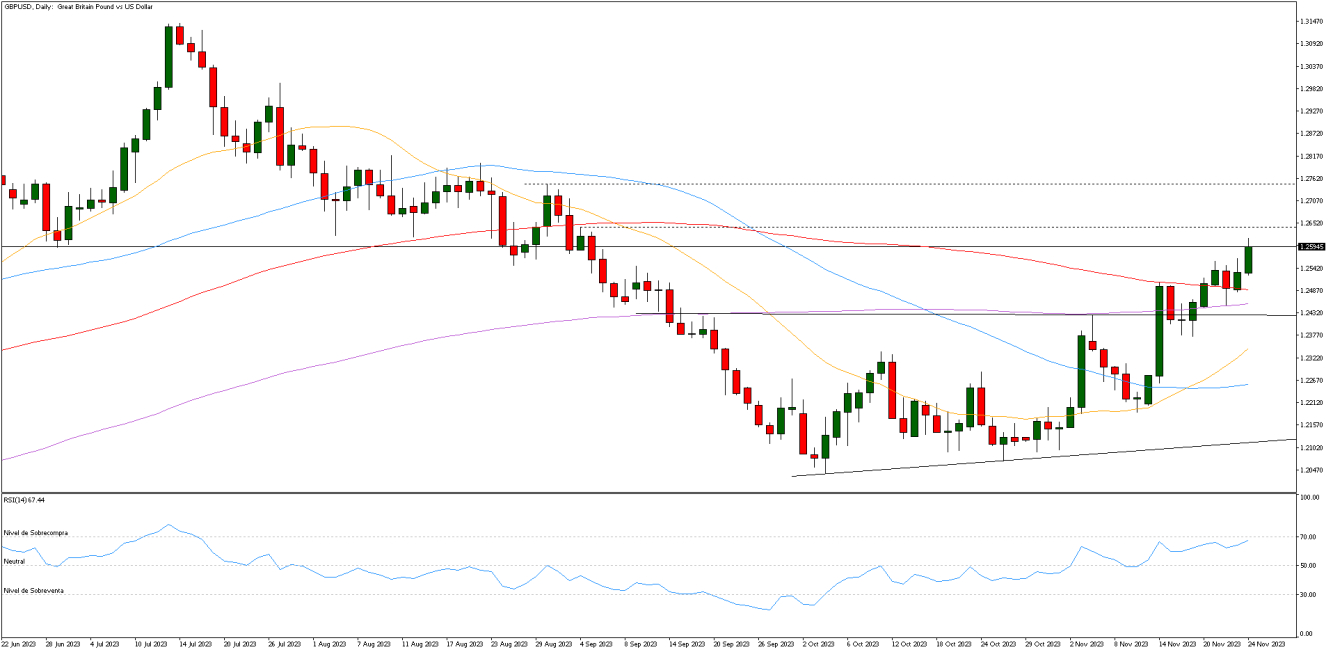The Pound Sterling gathered further strength against the United States Dollar (USD) this week, as GBP/USD renewed a two-month high just shy of the 1.2600 level. The pair remains exposed to further upside risks, in the face of a bullish technical setup on the daily chart, heading into a relatively data-light week.
Pound Sterling helped by dovish Fed bets, UK fundamentals
Having retained the upper hand a week ago, Pound Sterling buyers flexed their muscles amid a persistent bearish bias around the US Dollar. The recent series of consumer spending and inflation data bolstered bets for a US Federal Reserve (Fed) interest rate cut as early as May next year.
Dovish Fed expectations kept the US Treasury bond yields under pressure, undermining the US Dollar valuations. Markets continued pricing nearly a 50% chance of a May Fed rate cut despite upbeat US weekly Initial Jobless Claims data.. Initial claims for state unemployment benefits dropped by 24,000 to 209,000 for the week ended Nov. 18, reversing the jump in the prior week to a three-month high.
The US Dollar buyers also struggled to find any support from the Fed’s November meeting’s Minutes published on Tuesday. The Minutes revealed that “participants noted that further tightening of monetary policy would be appropriate if incoming information indicated that progress toward the Committee's inflation objective was insufficient” These hawkish comments failed to trigger a significant upside move.
The US business activity held steady in November, the preliminary Composite PMI published by S&P Global showed on Friday, failing to have any positive impact on the US Dollar.
On the other hand, the Pound Sterling capitalized on the hawkish commentaries from the Bank of England (BoE) policymakers during their parliamentary hearings on the November Monetary Policy Report (MPR) on Tuesday. Commenting on the interest rate outlook, BoE Governor Andrew Bailey said “risks are on the upside.”
Meanwhile, on inflation, Bailey noted that “markets underestimate risk of inflation persistence.” BoE policymaker Catherine Mann said that “the prospects for more persistent inflation imply a need for tighter monetary policy.”
GBP/USD received an additional boost from strong UK preliminary business PMI data, which showed that the country’s services sector returned to expansion in November, with a 50.5 reading. Meanwhile, buyers also cheered British Finance Minister Jeremy Hunt’s announcement of tax cuts for workers and permanent investment incentives for businesses in his Autumn Statement fiscal update.
Some industry experts said that the fiscal stimulus offered by Finance Minister Hunt increases the likelihood that the BoE will delay cutting interest rates.
Key events to watch out for Pound Sterling traders
Following the Thanksgiving holiday-shortened week, Pound Sterling traders brace for a relatively quiet week on the macroeconomic front. The week begins with the mid-tier New Home Sales data from the United States on Monday, followed by the high-impact US Conference Board (CB) Consumer Confidence data on Tuesday.
That day will be also full of Fed policymakers taking center stage. Their commentary could be closely scrutinized for the market’s pricing of the Fed interest rate expectations.
Wednesday will feature the second estimate of the United States’ third-quarter Gross Domestic Product (GDP) release alongside a couple of minor data publications. In the UK, BoE Governor Bailey will deliver brief remarks at an event celebrating the 50th anniversary of the London Foreign Exchange Joint Standing Committee later on Wednesday.
Once again, the British economic calendar is devoid of any high-impact data on Thursday, and therefore, the focus will remain on the US Personal Consumption Expenditures (PCE) Price Index and weekly Jobless Claims data, which could significantly influence the Fed’s interest rate outlook and expectations. Also, of note will be the US Pending Home Sales data. Pound Sterling traders could closely scrutinize comments from the BoE’s hawkish dissenter Megan Greene on Thursday. At the November policy meeting, Greene voted in favor of a 25 basis points (bps) interest rate hike.
On Friday, market participants will brace for Fed Chair Jerome Powell’s appearance, as he is due to participate in a fireside chat titled "Navigating Pathways to Economic Mobility" at Spelman College, in Atlanta. It will be his last speech before the December Fed policy announcements as the Fed will enter its “blackout period” on December 2.
Ahead of Powell’s speech, the final manufacturing PMI data from the UK and the US will be reported, followed by the ISM Manufacturing PMI.
Pound Sterling traders will also pay close attention to geopolitics, amid a four-day temporary truce between Hamas and Israel that started on Friday.
GBP/USD: Technical Outlook
As observed on the daily chart, GBP/USD is aiming for the continuation of the uptrend, which gained further traction after an ascending triangle breakout was confirmed on November 14.
The 14-day Relative Strength Indicator (RSI) continues to hold firm above the 50 level while the pair trades above all the major Simple Moving Averages (SMA), keeping the bullish bias intact for the Pound Sterling.
Therefore, the door remains open for a test of the 1.2815 level, which is the measured triangle pattern target. However, the Pound Sterling is likely to meet an initial hurdle at around 1.2650. Further up, the October 30 high of 1.2735 could be put to the test.
On the downside, strong supports are seen at the 100-day and 200-day SMAs at 1.2498 and 1.2450, respectively. A sustained break below the latter could trigger a fresh downtrend toward the upward-pointing 21-day SMA at 1.2345.
The last line of defense for GBP/USD is seen at the horizontal 50-day SMA at 1.2264.


